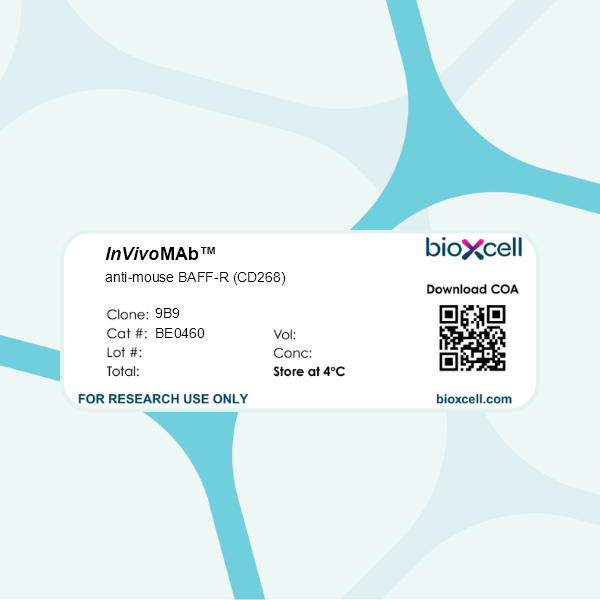InVivoMAb anti-mouse BAFF-R (CD268)
Product Description
Specifications
| Isotype | Rat IgG2b, κ |
|---|---|
| Recommended Isotype Control(s) | InVivoMAb rat IgG2b isotype control, anti-keyhole limpet hemocyanin |
| Recommended Dilution Buffer | InVivoPure pH 7.0 Dilution Buffer |
| Immunogen | Y3 cells overexpressing mouse BAFF-R |
| Reported Applications |
in vivo blocking of BAFF-R in vitro blocking of BAFF-R Flow cytometry |
| Formulation |
PBS, pH 7.0 Contains no stabilizers or preservatives |
| Endotoxin |
≤1EU/mg (≤0.001EU/μg) Determined by LAL assay |
| Purity |
≥95% Determined by SDS-PAGE |
| Sterility | 0.2 µm filtration |
| Production | Purified from cell culture supernatant in an animal-free facility |
| Purification | Protein G |
| Molecular Weight | 150 kDa |
| Storage | The antibody solution should be stored at the stock concentration at 4°C. Do not freeze. |
| Need a Custom Formulation? | See All Antibody Customization Options |
Application References
in vivo blocking of BAFF-R
Levit-Zerdoun E, Becker M, Pohlmeyer R, Wilhelm I, Maity PC, Rajewsky K, Reth M, Hobeika E. (2016). "Survival of Igα-Deficient Mature B Cells Requires BAFF-R Function" J Immunol 196(5):2348-60.
PubMed
Expression of a functional BCR is essential for the development of mature B cells and has been invoked in the control of their maintenance. To test this maintenance function in a new experimental setting, we used the tamoxifen-inducible mb1-CreER(T2) mouse strain to delete or truncate either the mb-1 gene encoding the BCR signaling subunit Igα or the VDJ segment of the IgH (H chain [HC]). In this system, Cre-mediated deletion of the mb-1 gene is accompanied by expression of a GFP reporter. We found that, although the Igα-deficient mature B cells survive for >20 d in vivo, the HC-deficient or Igα tail-truncated B cell population is short-lived, with the HC-deficient cells displaying signs of an unfolded protein response. We also show that Igα-deficient B cells still respond to the prosurvival factor BAFF in culture and require BAFF-R signaling for their in vivo maintenance. These results suggest that, under certain conditions, the loss of the BCR can be tolerated by mature B cells for some time, whereas HC-deficient B cells, potentially generated by aberrant somatic mutations in the germinal center, are rapidly eliminated.
Flow Cytometry
Santiago-Raber ML, Amano H, Amano E, Fossati-Jimack L, Swee LK, Rolink A, Izui S. (2010). "Evidence that Yaa-induced loss of marginal zone B cells is a result of dendritic cell-mediated enhanced activation" J Autoimmun 34(4):349-55.
PubMed
The development of systemic lupus is accelerated by the Yaa (Y-linked autoimmune acceleration) mutation, which is the consequence of a translocation of the telomeric end containing the Tlr7 gene from the X chromosome onto the Y chromosome. However, the loss of marginal zone (MZ) B cells, one of the Yaa-linked cellular abnormalities, has previously been shown to be unrelated to the Tlr7 gene duplication, and the present study therefore aimed to investigate the mechanism responsible for MZ B-cell loss. Analyses of Yaa and non-Yaa C57BL/6 male mice expressing an MD4 anti-HEL IgM transgene or those deficient in fms-like tyrosine kinase 3 ligand (FL) revealed that the proportion of MZ B cells in these Yaa mice was comparable to that of the respective non-Yaa control mice. Notably, the activation of MZ B cells was compromised in both of these transgenic model systems, due to the absence of cognate antigens or the impaired development of dendritic cells, respectively. These results contrasted with the loss of MZ B cells in non-Yaa mice treated with FL and the lack of accumulation of MZ B cells in Yaa mice treated with a B-cell survival factor, BAFF. Taken together, our results suggest that the persistent and enhanced activation of Yaa-bearing hyperactive MZ B cells by dendritic cells is responsible for the loss of this B-cell subset in Yaa mice.

